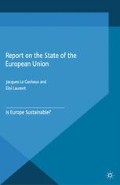Abstract
Only weeks after a new European Parliament was elected in May 2014 for a five-year mandate, the European Council met in Brussels to designate the new President of the Commission and negotiate the content of the policy program to be implemented by the incoming Commission over the next five years. Since 2009, the Lisbon Treaty rules that the European Parliament has to vote, with a simple majority, to confirm the Council’s choice for the Commission. In the campaign preceding the May 2014 election, this step in the direction of a “more democratic” functioning of the European Union (EU) institutions was presented as a major innovation, and each of the main political groups in the European Parliament designated its champion for the election of the Commission’s President. This move was supposed to make stakes clearer for European citizens and to favor a debate over the policy platforms: as in all parliamentary democracies, voters would be called to choose a party, hence a candidate for the Commission’s presidency and a proposed set of policy orientations for the EU over the next five years. The outcome of the May election was not quite as expected: with very low voter participation in most EU member states and no clear majority in the newly elected Parliament, it would seem only natural that negotiations be conducted by the main political groups to form a coalition and define the roadmap for the new Commission. But is there any choice to be made with regard to EU common policies?
Access this chapter
Tax calculation will be finalised at checkout
Purchases are for personal use only
Preview
Unable to display preview. Download preview PDF.
References
Begg, I., Enderlein, H., Le Cacheux, J. and Mrak, M. (2008). “Financing of the European Union Budget”, Report to the EC Commission, November, www.europa.eu.
Cattoir, P. (2004) “Tax-Based EU Own Resources: An Assessment”, Working Paper, https://ideas.repec.org/p/tax/taxpap/0001.html.
Dall’Erba, S. and Le Gallo, J. (2008) “Regional Convergence and the Impact of European Structural Funds over 1989–1999: A Spatial Econometric Analysis”. Papers in Regional Science 87 (2), June: 219–244.
Dullien, S. (2013) “A European Unemployment Insurance as a Stabilization Device — Selected Issues”, European Commission DG EMPL.
EC Commission (1977) Report on the Role of Public Finances in the Process of European Integration (McDougall Report), Brussels.
Fayolle, J. and Lecuyer, A. (2000) “Croissance régionale, appartenance nationale et fonds structuresl européens. Un bilan d’étape”. Revue de l’OFCE 73, April, http://www.ofce.sciences-po.fr/pdf/revue/4–73.pdf.
Fitoussi, J.P. and Le Cacheux, J. (eds) (2010) Report on the State of the European Union, Vol. 3, Crisis in the EU Economic Governance, London: Palgrave MacMillan.
Le Cacheux, J. (2005) “European Budget: The Poisonous Budget Rebate Debate”. Note de Notre Europe 47, June, www.notre-europe.asso.fr.
Le Cacheux, J. (2007a) “To Co-ordinate or Not to Co-ordinate: An Economist’s Perspective on the Rationale for Fiscal Policy Co-ordination in the Euro Zone” in Linsenman, I., Meyer, C. and Wessels, W. (eds) Economic Government of the EU. A Balance Sheet of New Modes of Policy Coordination, London: Palgrave MacMillan, 37–52.
Le Cacheux, J. (2007b) “Funding the EU Budget with a Genuine Own Resource: The Case for a European Tax”. Notes de Notre Europe 57, May, http://www.notre-europe.eu/.
Le Cacheux, J. and Sterdyniak, H. (2003) “Comment améliorer les performances économiques de l’Europe?” Revue de l’OFCE 87, October, http://www.ofce.sciences-po.fr/pdf/revue/6–87.pdf.
Lellouch, T. and Sode, A. (2014) “Une assurance chômage pour la Zone euro”. Trésor éco, French Treasury, No.132, June, http://www.tresor.economie.gouv.fr/File/403123
Mundell, R. (1961) “A Theory of Optimal Currency Areas”. American Economic Review 51 (4), September: 657–665.
Musgrave, R. (1959) The Theory of Public Finance, New York, NY: Mc-Graw Hill. Thuillier, (2014)
Sala-I-Martin, X. and Sachs, J. (1991) “Fiscal Federalism and Optimum Currency Areas: Evidence for Europe from the United States”. NBER Working Paper 3855, October, http://www.nber.org/papers/w3855.
Sapir, A. et al. (2004) An Agenda for a Growing Europe, Oxford: Oxford University Press.
Zumer, F. (1998) “Stabilisation et redistribution budgétaires entre regions: Etat centralisé, Etat fédéral”. Revue de l’OFCE 65, April, http://www.ofce.sciences-po.fr/pdf/revue/7–65.pdf.
Author information
Authors and Affiliations
Copyright information
© 2015 Jacques Le Cacheux and Eloi Laurent
About this chapter
Cite this chapter
Le Cacheux, J., Laurent, E. (2015). The European Budget: Seven Years of Stillness?. In: Report on the State of the European Union. Palgrave Macmillan, London. https://doi.org/10.1057/9781137451088_6
Download citation
DOI: https://doi.org/10.1057/9781137451088_6
Publisher Name: Palgrave Macmillan, London
Print ISBN: 978-1-349-49719-5
Online ISBN: 978-1-137-45108-8
eBook Packages: Palgrave Economics & Finance CollectionEconomics and Finance (R0)

